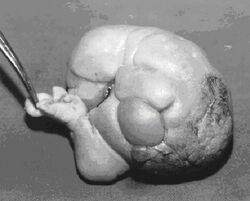Medicine:Fetus in fetu
Fetus in fetu (or foetus in foetu) is a rare developmental abnormality in which a mass of tissue resembling a fetus forms inside the body of its twin. An early example of the phenomenon was described in 1808 by George William Young.[1]
There are two hypotheses for the origin of a "fetus in fetu". One hypothesis is that the mass begins as a normal fetus but becomes enveloped inside its twin.[2] The other hypothesis is that the mass is a highly developed teratoma. "Fetus in fetu" is estimated to occur in 1 in 500,000 live births.[3]
Classification as life
A fetus in fetu can be considered alive, but only in the sense that its component tissues have not yet died or been eliminated. Thus, the life of a fetus in fetu is akin to that of a tumor in that its cells remain viable by way of normal metabolic activity. However, without the gestational conditions in utero with the amnion and placenta, a fetus in fetu can develop into, at best, an especially well differentiated teratoma; or, at worst, a high-grade metastatic teratocarcinoma. In terms of physical maturation, its organs have a working blood supply from the host, but all cases of fetus in fetu present critical defects, such as no functional brain, heart, lungs, gastrointestinal tract, or urinary tract. Accordingly, while a fetus in fetu can share select morphological features with a normal fetus, it has no prospect of any life outside of the host twin. Moreover, it poses clear threats to the life of the host twin on whom its own life depends.[4]
Hypotheses of development
There are two main hypotheses about the development of fetus in fetu.
Teratoma hypothesis
Fetus in fetu may be a very highly differentiated form of dermoid cyst, itself a highly differentiated form of mature teratoma.[5]
Parasitic twin hypothesis
Fetus in fetu may be a parasitic twin fetus growing within its host twin. Very early in a monozygotic twin pregnancy, in which both fetuses share a common placenta, one fetus wraps around and envelops the other. The enveloped twin becomes a parasite, in that its survival depends on the survival of the host twin, by drawing on the host twin's blood supply. The parasitic twin is anencephalic (without a brain) and lacks some internal organs, and as such is unable to survive on its own. As the host twin has to "feed" the enveloped twin from the nutrients received over a single umbilical cord, they usually die before birth.[citation needed]
References
- ↑ "Case of a Fœtus found in the Abdomen of a Boy". Medico-Chirurgical Transactions 1: 236–264. 1808. PMID 20895115.
- ↑ "Fetus-in-fetu in the pelvis". Annals of the Academy of Medicine Singapore 34: 646–9. 2005. http://annals.edu.sg/pdf/34VolNo10200511/V34N10p646.pdf.
- ↑ "Foetus-in-foetu". The Medical Journal of Australia 1 (20): 1016–1019. May 1969. doi:10.5694/j.1326-5377.1969.tb49866.x. PMID 5815070. — source not consulted; cited here following "Fetus in fetu: a case report and literature review". Pediatrics 105 (6): 1335–1344. June 2000. doi:10.1542/peds.105.6.1335. PMID 10835078.
- ↑ "Fetus in fetu: a case report". Journal of Medical Case Reports (Jmedicalcasereports.com) 2 (1): 2. January 2008. doi:10.1186/1752-1947-2-2. PMID 18186928.
- ↑ "Fetus in fetu or differentiated teratomas?". Indian Journal of Pathology & Microbiology 49 (4): 563–565. October 2006. PMID 17183856.
External links
 |




